|

| TBJ
offers personalized, exclusive services and management
for private jet travel. From corporate jets seating
6-15 passengers to large VIP-configured business
jets accommodating 15 to 150+ passengers. TBJ invites
you to enjoy our better-than-first-class private
air service wrapped in the finest 21st century lifestyle.
Enjoy five-star private jet travel in a safe and
secure flight environment, while our dedicated flight
team manages the nuances of your trip. We oversee
all the details of your private air travel - from
the on-board amenities to the distribution of up-to-the
minute itinerary information. Our private aviation
and hospitality teams work hard to earn your business
every time you fly.
At
TBJ our world revolves around you.
We'll
even let you pick your own colour aircraft
|
|
Callsign ~ BizJetz
(download here)
|
ALSO CHECK THE PAYWARE HANGARS
|
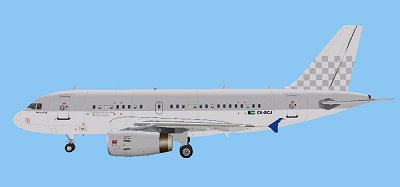
C6-BCJ
'William Kidd'
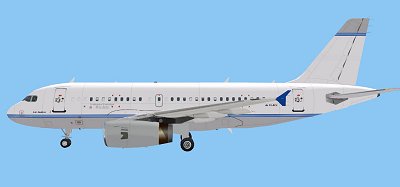
PJ-ACJ
'John Rackham'
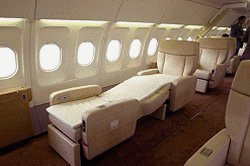
FS9
ONLY
Both
in same zip

|
Airbus
Corporate Jetliner ACJ ~ iFDG
This
is the corporate jet version of the A319 (-100X/CJ).
It incorporates extra fuel tanks which are installed
in the cargo compartment giving a range of 6,500 nautical
miles (12,000 km). Upon resale the aircraft can be reconfigured
as a standard A319 by removing its extra tanks, thus
maximizing its resale value. It is also known as the
ACJ, or Airbus Corporate Jet.
The
A319 is used by the Escadron de transport, d'entraînement
et de calibrage which is in charge of transportation
for France's officials. Since 2003, an ACJ is the main
presidential aircraft of Brazil.
The
aircraft seats up to 39 passengers but may be outfitted
by the customers into any configuration. DaimlerChrysler,
Reliance Industries and PrivatAir are among its users.
The A319CJ competes with other corporate jets such as
the Gulfstream V, the Boeing 737-700 based Boeing Business
Jet (BBJ1), and Bombardier's Global Express. It is powered
by the same engine types as the A320.
|
WEIGHT DATA
Maximum Takeoff Weight (kg) ______ 75500
CABIN DIMENSIONS
Maximum pax ______ 48
Optimal pax ______ 25
Cabin Length (m) ______ 23.78
Cabin width (m) ______ 3.7
Cabin height (m) ______ 2.21
Cabin volume (ku m) ______ 169.91
FLIGHT CAPACITY
Range (km) ______
• 8 passengers ______ 12600
• 25 passengers ______ 12100
• 48 passengers ______ 11100
Normal Cruise Speed (kmph) ______ 850
Maximum Operating Altitude (m) ______ 12500
TECHNICAL DATA
Length (m) ______ 33.84
Height overall (m) ______ 11.76
Wingspan (m) ______ 34.1
|
|
|
Other ESSENTIAL
Files:
Panel & Sound
aliased to the TCA A320
|
Repaint by JF
FDE by Karl Hajek
configured
as:
-large gourmet galley
, 2 F/A
-secretarial office for 2 secretaries
-2 Conference Rooms seating for 12 Exec each
-CEO office
-lavatories
-shower
-CEO bedroom
|
|
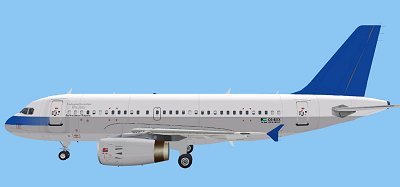
C6-EXX
'Bartholomew Roberts'
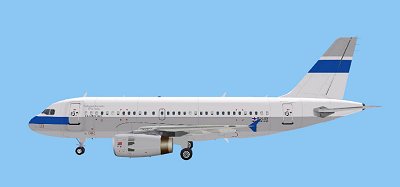
PJ-LUX
'Louis-Michel Aury'
(Texture
Only - needs C6-EXX installed)

FS9
ONLY

|
Airbus
A319-100LR ~ iFDG
This
version features an all-business class layout with 48
- 52 seats, specifically tailored for exclusive business
class services on intercontinental routes. The A319LR,
compared to the A319CJ, has four auxiliary fuel tanks
instead of six. Typical range is 4,500 nautical miles
(8300 km).
Lufthansa
operates a premium business service between Germany
and the USA using a fleet of A319LRs operated by the
Swiss PrivatAir. However, Qatar Airways fit their A319LRs
with standard seatings with 110 seats.
The
closest Boeing equivalent is the 737-700ER.
TBJ
operate schedules
on behalf of the parent company.
Also
see the AI hangar
|
WEIGHT DATA
Maximum Takeoff Weight (kg) ______ 75500
CABIN DIMENSIONS
Maximum pax ______ 48
Optimal pax ______ 25
Cabin Length (m) ______ 23.78
Cabin width (m) ______ 3.7
Cabin height (m) ______ 2.21
Cabin volume (ku m) ______ 169.91
FLIGHT CAPACITY
Range (km) ______
• 8 passengers ______ 12600
• 25 passengers ______ 12100
• 52 passengers ______ 11100
Normal Cruise Speed (kmph) ______ 850
Maximum Operating Altitude (m) ______ 12500
TECHNICAL DATA
Length (m) ______ 33.84
Height overall (m) ______ 11.76
Wingspan (m) ______ 34.1
|
|
|
Other ESSENTIAL
Files:
Panel & Sound
aliased to the TCA A320
|
Repaint by JF
FDE by Karl Hajek
configured
as:
-large gourmet galley
, 4 F/A
-Luxury seating for 52
-lavatories
-shower
|
|
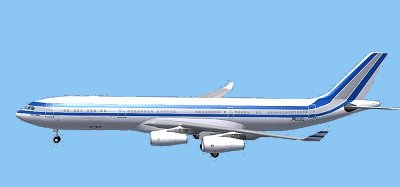
A6-EBZ
'William
Dampier'
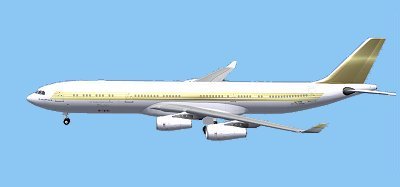
V8-BIZ
'Maurycy Beniowski'

FS9
ONLY
Both
in same zip
|
Airbus
A340-300E Prestige ~ Posky
Based
on Singapore Airlines highly successful A340-313E *Celestial*
this Executive Aircraft is second to none in top-level
Executive transport terms.
Featuring
an interior selected with utmost care and the need for
a quiet, relaxing atmosphere in which decisions can
be made in peace of mind, this long-range VIP transport
offers a Public Relations Centre with satellite link,
an enlarged gourmet galley and a bath and jacuzzi. In
case of any need there is also a medical centre and
I.C.U. situated in the mid-cabin.
For
additional peace this aircraft offers a completely noise-free
meditiation room as well as 6 large bedrooms and 2 additional
showers. A specially trained cabin crew of 8 VIP multi-lingual
Flight Attendants look after each and every need of
the guests. Four highly skilled secretaries who also
hold a valid RN rating stationed in the PR centre (and
optionally in the surgery) complement the services offered.
|
WEIGHT DATA
Maximum Takeoff Weight (kg) ______ 271,000
CABIN DIMENSIONS
Maximum pax ______
Optimal pax ______
Cabin Length (m) ______
Cabin width (m) ______
Cabin height (m) ______
Cabin volume (ku m) ______
FLIGHT CAPACITY
Range (km) ______ 12,415
• ______
Normal Cruise Speed (Mach) ______ 0.84
Maximum Operating Altitude (FL) _____ 370
TECHNICAL DATA
Length (m) ______ 63.70
Height overall (m) ______ 16.74
Wingspan (m) ______ 60.30
Wing area (m2) ______ 363.1
|
|
|
Other ESSENTIAL
Files:
|
Repaint by JF
FDE by Karl Hajek
configured
as:
-large gourmet galley
-8 F/A
-public relations centre (cap.32) with direct satellite link
-fwd conference area (30)
-medical room + intensive care unit with onboard physician
-large bath and jacuzzi
-meditation room
-aft conference room (cap 30)
-CEO bedroom
-2 additional twin bedrooms
-2 showers
|
|
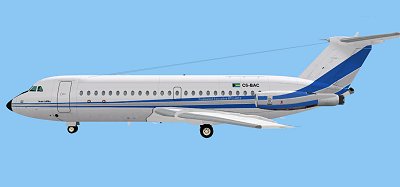
C6-BAC
'Jean Laffite'
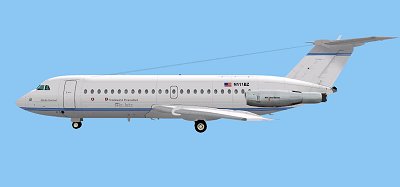
N111BZ
'Stede Bonnet'
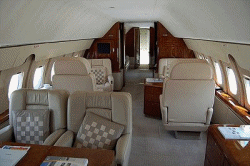
FS9
ONLY
Both
in same zip

|
BAC
1-11 475 HK ~ David Maltby
The
One-Eleven can trace its origins back to the proposed
Hunting H-107 jet airliner project of 1956.
Protracted
development followed, but by 1961, when Hunting had
been absorbed into British Aircraft Corporation (BAC),
a larger Rolls-Royce Spey turbofan powered design was
finalised.
British
United Airways placed a launch order for 10 of the new
jets, then known as the BAC-111, in May 1961. The new
aircraft took to the skies for the first time on August
20 1963, while the first production Series 200 first
flew on December 19 1963. Certification was eventually
awarded on April 6 1965, following a troubled flight
test program, during which one prototype crashed with
the loss of its crew, the cause attributed to deep stall
from the rear engine and the T-tail configuration. With
the deep stall issue resolved, the BAC-111 entered service
on April 6 1965.
Development
of the basic Series 200 led to the higher weight Series
300, followed by the Series 400 designed for American
requirements with a higher US equipment content.
The
Series 500 introduced a 4.11m (13ft 6in) stretched fuselage
and lengthened wings and greater seating capacity for
up to 119 passengers. It first flew (converted from
a -400) on June 30 1967. The Series 475 was optimised
for hot and high operations and combined the Series
500's more powerful engines with the earlier shorter
length fuselage.
The
last UK built One-Eleven (by this time a British Aerospace
product) flew in 1982, by which time production was
progressively being transferred to Bucuresti in Romania
where nine were built as the Rombac 1-11.
The
best choice for the discerning Executive who takes just
the step beyond - from the ultimate in personal travel
comfort to also making an appearance by arriving in
this classic British jetliner, which has been refurbished
to meet even the most exacting standards in flight safety
as well as luxury travel, yet at competitive rates
|
WEIGHT DATA
Maximum Takeoff Weight (kg) ______ 40,153
CABIN DIMENSIONS
Maximum pax ______ 30
Optimal pax ______ 25
Cabin Length (m) ______ 17.5
Cabin width (m) ______ 3.2
Cabin height (m) ______ 2
Cabin volume (ku m) ______
FLIGHT CAPACITY
Range (km) ______ 2300
• 8 passengers ______
• 25 passengers ______
• 30passengers ______
Normal Cruise Speed (kmph) ______ 880
Maximum Operating Altitude (m) ______
TECHNICAL DATA
Length (m) ______ 28.50
Height overall (m) ______ 7.47
Wingspan (m) ______ 26.97
Wing area (m2) _______ 93.2
|
|
|
Other ESSENTIAL
Files:
2D
panel, Virtual cockpit & manual
Rolls-Royce
Spey engine sounds (two engines + APU)
|
Repaint by JF
FDE by Karl Hajek
configured
as:
- seating for 18 Exec
in 3 cabins
- large galley
- 2 F/A
- 2 showers
- twin bedroom
|
|
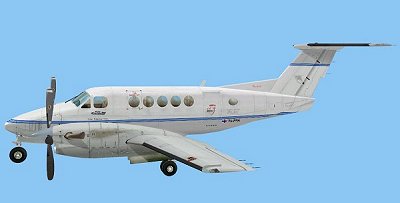
PJ-PPH
'Pieter Pietersen
Heyn'
plus
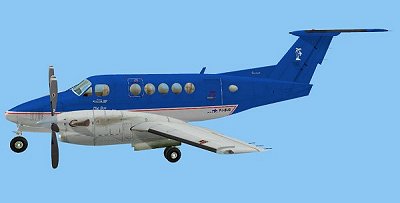
PJ-BUS
'The Bus' Crew Transfer
Aircraft
FS9
ONLY
|
Beech
King Air 300 ~ AFG
The
King Air 300 is an updated version of the successful B200
series, and it itself was replaced by the further improved
King Air 350, the latest model in this long running and
successful line of corporate and utility transports.
Design
of an improved development of the successful King Air
B200 began in August 1981, the 14 month design effort
culminating in the first flight of the modernised 300
model in October the following year. Improvements to the
B200 were many, with the main change being the installation
of more powerful PT6A60A turboprops in place of the 42s
of the earlier model. Other changes included reprofiled
and more aerodynamically clean engine cowls and exhausts
and extended wing leading edges, plus minor internal changes.
Both empty and max takeoff weights were also increased.
The
max weight was reduced for the 300LW or `Light Weight',
intended to minimise the effects of weight based airways
user fees, particularly in Europe. The 300AT was an airline
pilot trainer.
The
King Air 300 has been replaced by the 350, its major improvements
being a stretched fuselage lengthened by 86cm (2ft 10in)
and the addition of winglets. The latest member of the
King Air family, it had its first flight in 1988, and
has been in production since late 1989. The King Air 350C
features a builtin airstair and a 132 x 132cm (52 x 52in)
freight door. The 350 is also available in a range of
special missions and military variants.
The
`Super' prefix was dropped from the King Air name in 1996.
|
|
|
Other ESSENTIAL Files:
|
Repaint by JF
|
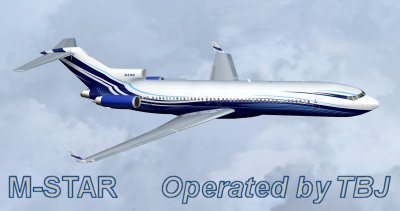
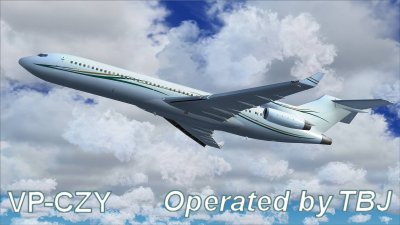
FS9 - FSX

|
Boeing
727-200 Adv - TDS
The
727-100 had been in service barely a year when Boeing
began serious consideration of a stretched, greater capacity
development.
This resulted in the 727-200, which Boeing announced it
was developing in August 1965. The 727-200 was essentially
a minimum change development of the 100, the only major
change being the 6.10m (20ft) fuselage stretch, which
increased maximum seating to 189 passengers. The 727-200's
stretch consisted of two 3.05m (10ft) plugs, one forward
and one rear of the wing. Otherwise the 727-100 and 200
shared common engines, fuel tank capacity and the same
maximum takeoff weight.
The first flight of the 727-200 occurred on July 27 1967,
with certification granted in late November that year.
The -200 was placed into service by launch customer Northeast
Airlines (this airline was later acquired by Delta) the
following month, by which time total 727 orders for both
models had exceeded 500.
The 727-200 helped broaden the sales appeal of the 727
considerably and snared significant sales. However the
200 was restricted by its relatively short range, due
to it having the same fuel capacity as the 727-100, so
Boeing developed the increased range Advanced 727-200.
First flown in March 1972 changes introduced on the Advanced
model included increased fuel capacity, and thus range,
the option of more powerful engines, quieter engine nacelles
and strengthened structure. The Advanced remained the
primary 727-200 production model until production ceased
in 1984.
The 727-200 remains popular with passengers and pilots
but it does not meet Stage 3 noise requirements. To overcome
this a number of hushkit programs are on offer while Valsan
converted 23 727s to its Stage 3 compliant Quiet 727 standard
(before the company collapsed). This retrofit included
installing JT8D-217s on the outer pylons and acoustic
treatment of the centre engine. Other 727s have been fitted
with winglets for improved performance.
|
|
Other Suggested Files:
|
Repaints by JF
Original Textures by:
Carlos Eduardo Salas and Simon O'Smotherly
features:
- 2 lounges seating 8 each (this is a flying cocktail bar)
- 2 conference rooms seating 6 and 8 respectively
- enlarged galley
- deluxe washroom
- 4500 gallon auxiliary tank fitted for extended range (eg. USA
mainland -
Hawaii, transcontinental USA)
|
|

P4-JTZ
'Robert Surcouf'

|
Boeing
727-200 QWRE ~ Vans
The
727-100 had been in service barely a year when Boeing
began serious consideration of a stretched, greater capacity
development.
This resulted in the 727-200, which Boeing announced it
was developing in August 1965. The 727-200 was essentially
a minimum change development of the 100, the only major
change being the 6.10m (20ft) fuselage stretch, which
increased maximum seating to 189 passengers. The 727-200's
stretch consisted of two 3.05m (10ft) plugs, one forward
and one rear of the wing. Otherwise the 727-100 and 200
shared common engines, fuel tank capacity and the same
maximum takeoff weight.
The first flight of the 727-200 occurred on July 27 1967,
with certification granted in late November that year.
The -200 was placed into service by launch customer Northeast
Airlines (this airline was later acquired by Delta) the
following month, by which time total 727 orders for both
models had exceeded 500.
The 727-200 helped broaden the sales appeal of the 727
considerably and snared significant sales. However the
200 was restricted by its relatively short range, due
to it having the same fuel capacity as the 727-100, so
Boeing developed the increased range Advanced 727-200.
First flown in March 1972 changes introduced on the Advanced
model included increased fuel capacity, and thus range,
the option of more powerful engines, quieter engine nacelles
and strengthened structure. The Advanced remained the
primary 727-200 production model until production ceased
in 1984.
The 727-200 remains popular with passengers and pilots
but it does not meet Stage 3 noise requirements. To overcome
this a number of hushkit programs are on offer while Valsan
converted 23 727s to its Stage 3 compliant Quiet 727 standard
(before the company collapsed). This retrofit included
installing JT8D-217s on the outer pylons and acoustic
treatment of the centre engine. Other 727s have been fitted
with winglets for improved performance.
|
|
|
Other Suggested Files:
|
Repaint by JF
PANEL & SOUND
aliased to default 737
FDE by Karl Hajek
configured
as:
features:
- 2 lounges seating 8 each (this is a flying cocktail bar)
- 2 conference rooms seating 6 and 8 respectively
- enlarged galley
- deluxe washroom
- 4500 gallon auxiliary tank fitted for extended range (eg. USA
mainland -
Hawaii, transcontinental USA)
|
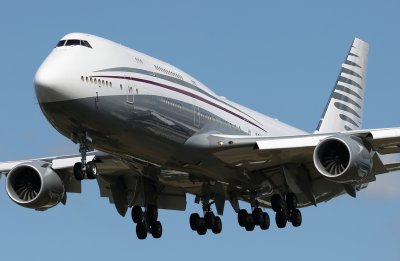
2-LOVE
Tradewind BizJetz

FS9
FSX
|
Boeing 747-8i Executive ~ SkySpirit
The Boeing 747-8 is a wide-body jet airliner developed by Boeing Commercial Airplanes. Officially announced in 2005, the 747-8 is the third generation of the 747, with lengthened fuselage, redesigned wings, and improved efficiency. The 747-8 is the largest 747 version, the largest commercial aircraft built in the United States, and the longest passenger aircraft in the world.[3]
The 747-8 is offered in two main variants: the 747-8 Intercontinental (747-8I) for passengers and the 747-8 Freighter (747-8F) for cargo.[4] The first 747-8F performed the model's maiden flight on February 8, 2010, with the 747-8 Intercontinental following on March 20, 2011. Delivery of the first freighter aircraft occurred in October 2011 and the passenger model began deliveries in 2012. As of August 2015, confirmed orders for the 747-8 total 123, comprising 72 of the freighter version, and 51 of the passenger version.
|
|
Other ESSENTIAL Files:
|
Repaint by JF
FSX version includes modified default VC
Includes a nice
2D panel
Both panels in grey
|
|
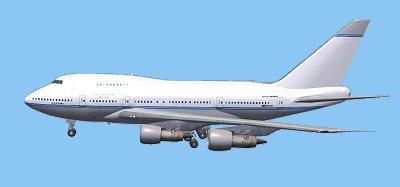
VP-BTE
'Samuel Bellamy'

A6-BZJ
'Henry Morgan'

FS9
ONLY
Both in
same zip
|
Boeing
747SP Executive ~ Posky
Boeing
developed the 747SP in the mid 1970s as a longer range,
shortened 747, trading passenger seating for extra range.
The 747SP is the only 747 model to feature a changed fuselage
length compared with the 747-100.
The
747SP first flew on July 4 1975, certification was awarded
on February 4 1976 and first delivery (to Pan American)
was in March 1976.
The
747SP's fuselage is shortened by 14.35m (47ft 1in) compared
to other 747 models, while the vertical tail was increased
in height to compensate for the reduced moment arm with
the shorter fuselage. Structurally the 747SP was lightened
in some areas because of the significant reduction in
gross weights. Overall though the 747SP retained 90% commonality
of components with the 747-100 and 200. While shortening
the 747's fuselage increased the fuel fraction and thus
range, it also meant that seating capacity was reduced.
The
SP suffix in 747SP stands for Special Performance, and
points to the ultra long range abilities of this 747 variant
that preceded the later 747-400 by 15 years. The 747SP's
range is best illustrated by the spate of long range distance
records it set in the mid 1970s. The most prominent of
those was the delivery flight of a South African Airways
SP, which over March 23/24 1976 flew nonstop with 50 passengers
from Paine Field in Washington State to Cape Town, South
Africa, a distance of 16,560km (8940nm). This world nonstop
record for a commercial aircraft stood until 1989 when
a Qantas 747-400 flew 17,945km (9688mn) nonstop from London
to Sydney.
Sales
of the 747SP were modest despite the increased range,
as the SP had poorer operating economics per seat compared
to the 747-200. However the 747SP did pioneer a number
of long range nonstop services that are now commonly flown
by the 747-400.
Notable
SP customers included South African Airways (who found
the SP's extended range a great asset in bypassing African
nations that denied it landing rights while South Africa's
apartheid policies were in place), Qantas and PanAm, the
latter pioneering nonstop trans Pacific Los Angeles/Sydney
services.
In
early 2005 less than twenty SPs remain in airline or corporate
service
|
WEIGHT DATA
Maximum Takeoff Weight (kg) ______ 317,515
CABIN DIMENSIONS
Maximum pax ______
Optimal pax ______
Cabin Length (m) ______
Cabin width (m) ______
Cabin height (m) ______
Cabin volume (ku m) ______
FLIGHT CAPACITY
Range (km) ______ 15,400
• ______
Normal Cruise Speed (kmph) ______
Normal Operating Altitude (FL) ______ 430
Maximum Operating Altitude (FL) ______ 450
TECHNICAL DATA
Length (m) ______ 56.31
Height overall (m) ______ 19.94
Wingspan (m) ______ 59.64
Wing area(m2) _______ 511
|
|
|
Other ESSENTIAL Files:
|
Repaint by JF
FDE by Karl Hajek
configured
as:
-large gourmet galley
-diningroom(30pax)
-stateroom A(30pax)
-XCR crew rest(8)
-stateroom B(30pax)
-recreational(10pax)
-LD Fwd
-water 1322 gal
Includes a nice
2D panel
|
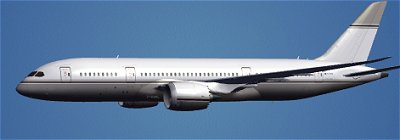
PJ-GHA TBJ BizJetz Trent 1000
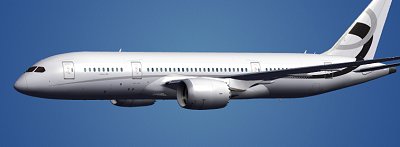
PJ-GHB TBJ BizJetz GenX
FSX
FSX (Aerosim Alias)
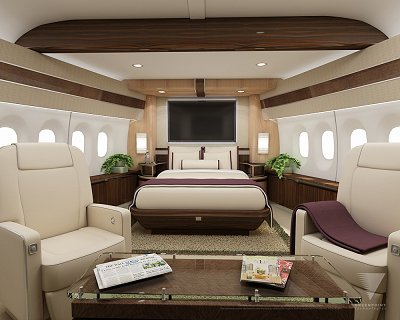
|
Boeing
787-800 ~ TDS
The Boeing 7E7 was announced on 29th January 2003 following the cancellation of the Sonic Cruiser. The aircraft was renamed the Boeing 787 in 2005.
This important design marked a major shift in technology for Boeing, which aimed for maximum fuel efficiency in a number of ways. Chief among these was a radical change of construction material, with much of the aircraft being built of carbon fibre reinforced plastic (CFRP). Additionally, the fuselage was produced as 'barrels' rather than sheets of material, reducing the number of fastenings required. This further increased the weight savings. Many of the aircraft's systems are now electrically operated, replacing the heavier hydraulic systems of earlier Boeing designs with lighter technology.
The engines are new designs with increased fuel efficiency. Both the General Electric GEnx and Rolls-Royce Trent 1000 designs are available. Boeing decided to use bleedless designs, another major change for aircraft of this class. Interestingly, Airbus decided not to use bleedless technology on its competing Airbus A350 design and it remains to be seen which approach offers the greatest benefits over the other. The rear engine nacelle has a distinctive rippled look which reduces noise as the engine exhaust and external air mix.
For passengers, there have been a number of technology improvements. Most noticeably, the windows are amongst the largest in a civil airliner and are lower on the fuselage than is usual, so that passengers have a better view downwards. The lighting system use LED technology allowing each customer great flexibility on the lighting schemes it can use. The pressurisation system features a lower cabin altitude than normal and allows increased humidity, both factors which will contribute to passenger comfort during a long flight.
With all these technology advances and a distributed manufacturing program that was very new to Boeing, it is not suprising that the program encountered a number of delays. However, the first aircraft was delivered to a customer, All Nippon Airways, in September 2011.
|
|
Other Suggested Files:
|
Repaint by JF
FSX version includes updated 738 VC
and 787 2D Panel
Also an option for Aerosim VC and sound alias
|
|
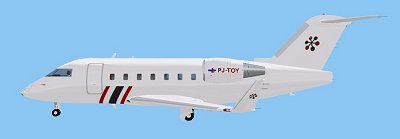
PJ-TOY
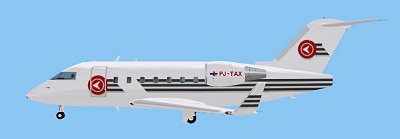
PJ-TAX
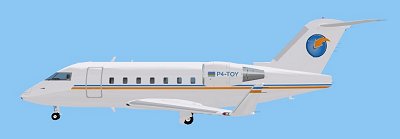
P4-TOY
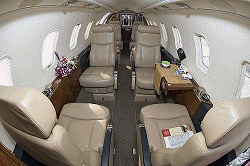
FS9
ONLY
All in
same zip
|
Bombardier
Challenger 604 ~ Premier
The
Challenger 601 addressed the original CL-600 Challenger's
weight problems and replaced the troubled ALF-502 turbofans,
creating a highly successful full size corporate jet.
Troubles with the Avco Lycoming powered Challenger 600
led Canadair (now a division of Bombardier) to develop
a vastly improved variant in the form of the General Electric
CF-34 powered Challenger 601. Another important change
was the addition of winglets, which are also offered as
a retrofit to earlier aircraft. The 601 first flew on
April 10 1982 and for a time was offered alongside the
600. The 600 was dropped from the model line in 1983.
Subsequent development of the Challenger led to the 601-3A.
First flying in 1987, this variant introduced an EFIS
glass flightdeck and upgraded engines. Available from
1989, the 601-3R was an extended range model with higher
weights (the range increase modifications can also be
retrofitted to earlier 601-3As).
Further improvements to the basic design led to the Challenger
604. Improvements include an advanced Collins ProLine
IV EFIS avionics system with colour displays, higher weights,
CF-34-3B turbofans and increased fuel tankage. Many other
minor changes were incorporated based on Bombardier's
experience with the Canadair Regional Jet. First flight
with CF-34-3A engines was in September 1994, first flight
with the CF-34-3B engines was on March 17 1995, with Transport
Canada certification granted that September. First delivery
was in January 1996.
|
|
|
Other ESSENTIAL Files:
|
Repaint by JF
configured as:
-1 F/A
-galley
-lavatory
-4 Exec Club Room
|
|
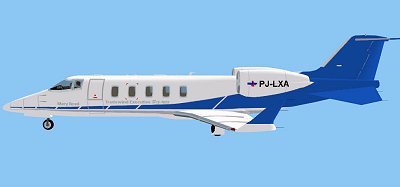
PJ-LXA
'Mary
Read'
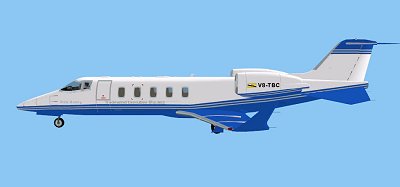
V8-TBC
'Anne Bonny'

FS9
ONLY
Both in
same zip

|
Bombardier
Learjet 60 ~ Premier
The
Learjet 55 and its followon successor, the Learjet 60,
are the largest members of the Learjet family, and date
back to development work undertaken in the late 1970s.
In
designing the 55, Learjet (or Gates Learjet as the company
was then known as) took the wing of the earlier Longhorn
28/29 series and married it to an all new larger 10 seat
fuselage. The original Model 55 Longhorn prototype first
flew on November 15 1979. The first production aircraft
meanwhile flew on August 11 1980, with the first delivered
in late April 1981 (after FAA certification was granted
in March that year).
Development
of the 55 led to a number of sub variants, including the
55B which introduced a digital flightdeck, modified wings,
improved interior, and most importantly, the previous
optional higher takeoff weights becoming standard. The
55C introduced `Delta Fins' which gave a number of performance
and handling advantages, the 55C/ER is an extended range
version with additional fuel in the tail cone (the additional
tank can be retrofitted to earlier aircraft), while the
55C/LR introduced more fuel capacity.
The
improved Learjet 60 first flew in its basic definitive
form in June 1991 (the modified Learjet 55 prototype earlier
served as a proof of concept aircraft for the 60 with
Garrett engines). It differs from the 55 in having a 1.09m
(43in) fuselage stretch and new Pratt & Whitney Canada
PW305 turbofans. Certification of the 60 was awarded in
January 1993, with first deliveries following shortly
afterwards.
|
WEIGHT DATA
Maximum Takeoff Weight (kg) ______ 10659
CABIN DIMENSIONS
Maximum pax ______ 8
Optimal pax ______ 6
Cabin Length (m) ______ 5.39
Cabin width (m) ______ 1.81
Cabin height (m) ______ 1.74
Cabin volume (ku m) ______ 12.83
FLIGHT CAPACITY
Range (km) ______
• ______ 4617
Normal Cruise Speed (kmph) ______ 846
Maximum Operating Altitude (m) ______ 15550
TECHNICAL DATA
Length (m) ______ 17.89
Height overall (m) ______ 4.44
Wingspan (m) ______ 13.35
|
|
|
Other ESSENTIAL Files:
|
Repaint by JF
FDE by Karl Hajek
configured
as:
-1 F/A
-galley
-lavatory
-4 Exec Club Room
|
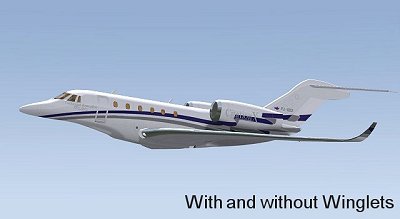
PJ-XBX Tradewind BizJets
FSX ONLY
|
Cessna Citation X ~ FSND
The Citation X is Cessna's largest, fastest and longest range aircraft yet, and Cessna claims it to be the fastest civil transport in service other than the supersonic Concorde.
The Citation X (as in the Roman numeral, not the letter, and Cessna's Model 750) is also the largest member of business aviation's biggest corporate jet family, the Citation series.
The design objectives behind the Citation X included transcontinental USA and trans Atlantic range in a mid size package that cruises faster than any other business jet available. This high speed cruise capability, which Cessna says is 105 to 210km/h (55 to 113kt) faster than other mid size corporate jet, means the X can save up to one hour's flight time on transcontinental US flights, flying from Los Angeles to New York with normal wind conditions in 4 hours 10 minutes. Because of its ability to cruise at high speed at high altitudes, Cessna also says the Citation X will consume less fuel than current jets on such a transcontinental flight.
The X's FADEC equipped Allison AE 3007A turbofans are very powerful for an aircraft of the X's size, while the highly swept (37°) wings are also long in span.
Other design features of the Citation X include the fuselage cross section of the Citation III, VI and VII but with more efficient use of internal space that allows greater head and shoulder room, an area ruled, waisted rear fuselage, trailing link main undercarriage units and a modern Honeywell Primus 2000 EFIS avionics suite with five colour CRT displays.
Cessna announced that it was developing the Citation X in October 1990 at that year's NBAA conference. The prototype was publicly rolled out in September 1993 and flew for the first time on December 21 that year. Certification was granted on June 3 1996, with the first customer delivery (to golfer Arnold Palmer) that month.
A Citation X was the 2500th Citation to be delivered, handed over on September 10 1997. The USA's National Aeronautics Association awarded its prestigious Collier Trophy to the Citation X design team in February 1997.
|
|
Other Essential Files:
|
Repaint by JF
|
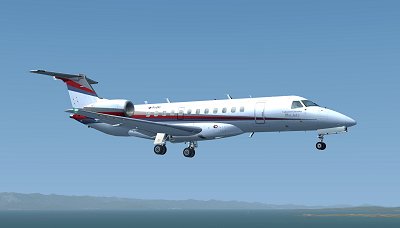
PJ-ERJ
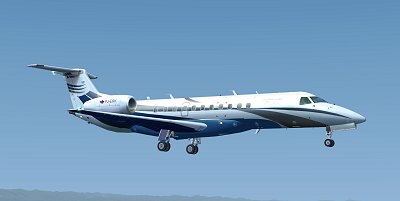
PJ-ERK
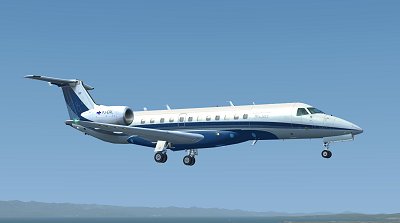
PJ-ERL
FS9 & FSX
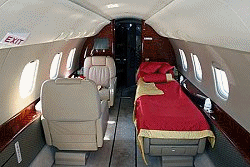
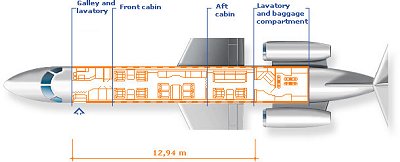
|
Embraer
ERJ135LR ~ Posky
The
ERJ-135 and more recent ERJ-140 are shortened developments
of the 50 seat ERJ-145
Embraer
launched the ERJ-135 on September 16 1997. Just nine and
a half months passed before first flight on July 4 1998
(following rollout on May 12 that year). A second prototype
first flew in October 1998
Few
new airliners have sold as quickly from their launch as
the ERJ-135. Building on the success of the 145, the 135's
order book stood at 145 at late 1998, barely a year after
launch
Meanwhile
at Farborough 2000 Embraer launched development of the
ERJ-135 based Legacy corporate jet. First flight (of a
converted ERJ-135) was on March 2001. The Legacy features
additional fuel giving a range with 10 passengers of 5930km
(3200nm).
Although
the marketing designations are ERJ-135, ERJ-140 and Legacy,
the certification designations remain as EMB-135ER/LR
for the ERJ-135ER/LR, EMB-135KL for the ERJ-140LR and
EMB-135BJ for the Legacy.
|
WEIGHT DATA
Maximum Takeoff Weight (kg) ______ 22500
CABIN DIMENSIONS
Maximum pax ______ 16
Optimal pax ______ 13
Cabin Length (m) ______ 12.94
Cabin width (m) ______ 2.11
Cabin height (m) ______ 1.83
Cabin volume (ku m) ______ 40
FLIGHT CAPACITY
Range (km) ______
• 8 passengers ______ 6019
• 4 pax and full fuel ______ 6302
Normal Cruise Speed (kmph) ______ 790
Maximum Operating Altitude (m) ______ 12500
TECHNICAL DATA
Length (m) ______ 26.33
Height overall (m) ______ 6.76
Wingspan (m) ______ 21.17
|
|
Other Essential Files:
|
Repaint by JF
|
|
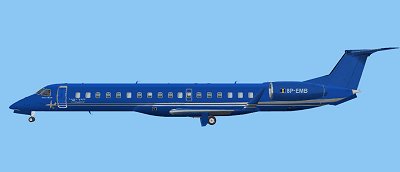
8P-EMB
'Edward Teach'

8P-ERJ
'Roche Braziliano'
Both in
same zip
FS9
ONLY


|
Embraer
Legacy ~ Dreamwings
The
ERJ-135 and more recent ERJ-140 are shortened developments
of the 50 seat ERJ-145
Embraer
launched the ERJ-135 on September 16 1997. Just nine and
a half months passed before first flight on July 4 1998
(following rollout on May 12 that year). A second prototype
first flew in October 1998
Few
new airliners have sold as quickly from their launch as
the ERJ-135. Building on the success of the 145, the 135's
order book stood at 145 at late 1998, barely a year after
launch
Meanwhile
at Farborough 2000 Embraer launched development of the
ERJ-135 based Legacy corporate jet. First flight (of a
converted ERJ-135) was on March 2001. The Legacy features
additional fuel giving a range with 10 passengers of 5930km
(3200nm).
Although
the marketing designations are ERJ-135, ERJ-140 and Legacy,
the certification designations remain as EMB-135ER/LR
for the ERJ-135ER/LR, EMB-135KL for the ERJ-140LR and
EMB-135BJ for the Legacy.
|
WEIGHT DATA
Maximum Takeoff Weight (kg) ______ 22500
CABIN DIMENSIONS
Maximum pax ______ 16
Optimal pax ______ 13
Cabin Length (m) ______ 12.94
Cabin width (m) ______ 2.11
Cabin height (m) ______ 1.83
Cabin volume (ku m) ______ 40
FLIGHT CAPACITY
Range (km) ______
• 8 passengers ______ 6019
• 4 pax and full fuel ______ 6302
Normal Cruise Speed (kmph) ______ 790
Maximum Operating Altitude (m) ______ 12500
TECHNICAL DATA
Length (m) ______ 26.33
Height overall (m) ______ 6.76
Wingspan (m) ______ 21.17
|
|
|
Other Essential Files:
Important aircraft.cfg update
only required if you downloaded before 21 Feb 2007
|
Repaint by JF
|
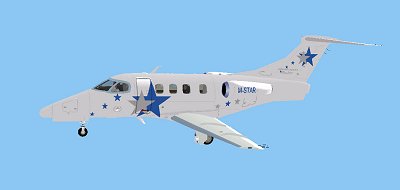
M-STAR Phenom 100
FS9
ONLY
FSX
ONLY
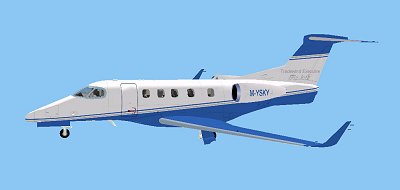
M-YSKY Phenom 300
FS9
ONLY
FSX
ONLY


|
Embraer
Phenom 100 & 300 ~ CamSim
The
Embraer
Phenom 100 has a capacity for 4 passengers in its normal configuration, but it can carry up to 6-7 passengers with a single crew, optional side facing seat and belted toilet. It has a maximum flying range of 1,178 nautical miles with 4 occupants and NBAA IFR Reserves.
The
Embraer
Phenom 300 is a light jet aircraft can carry 8 or 9 occupants with a flying range of 1,971 nautical miles.
N.B. There is NO VC in this aircraft
|
|
Other Essential Files:
|
Repaint by JF
N.B. There is NO VC in this aircraft
|
|

PJ-GLS

FS9
ONLY

|
Gates
Learjet 25D ~ Lars Roennig
One
of the world's largest, fastest, best selling and well
known series of business jets, the Learjet family began
with the original six to eight seat Lear Jet 23 which
first flew on October 7 1963.
The 23 originated in Switzerland, where William P. Lear
had formed the Swiss-American Aviation Corporation (SAAC)
in 1960 to manufacture a twin-jet high-speed executive
aircraft, the SAAC-23. This aircraft was designed and
conceived by Dr.eng. Hans-Luzius Studer, who previously
had developed the FFA P-16 fighter. The aerodynamics and
many other characteristics of the 23 were taken over from
the P-16. Although it was originally planned to manufacture
at least the first 25 Lear Jets in Switzerland, production
was transferred to the United States, where Lear had founded
Lear Jet Corporation.
The diminutive Model 23 pioneered an entirely new market
segment for the light business jets, and proved very successful.
The first production 23 was delivered in October 1964,
but was replaced by the improved Model 24 in 1966 after
105 had been built. The 24, which introduced uprated engines
and a number of detail changes, first flew in February
1966 and was delivered from the middle of that year. Developments
of the 24 included the 24D, E and F, introducing improvements
such as increased weights, thrusts, and range.
The Learjet 25 introduced a 1.27m (4ft 2in) fuselage stretch
allowing seating for up to eight passengers and was first
flown on August 12 1966, and, like the 24, a number of
subsequent developments were built, including the B, C,
and D.
In 1966 the name of the manufacturer changed to Lear Jet
Industries, and in January 1970 Gates Rubber Company,
who had bought a controlling interest, changed the name
again, to Gates Learjet Corporation.
The unsuccessful Gates Learjet 28 and 29 Longhorns are
based on the 25 but introduced a new increased span wing
fitted with winglets, which improved fuel efficiency and
overall performance, particularly payload range and fuel
economy. The Longhorn 28 seats up to eight passengers,
the similar dimensions Longhorn 29 sacrifices two seats
for extra range. Production of the family ceased in 1982.
Learjets are known for their tight accomodation. Max internal
cabin width is just 1.50m (4ft 11in), max height 1.32m
(4ft 4in)
|
Powerplants
23 - Two 12.7kN (2850lb) General Electric CJ610-4 turbojets.
25D/29 - Two 13.1kN (2950lb) CJ610-8As.
Performance
23 - Max speed 860km/h (465kt), max cruising speed 850km/h
(460kt), economical cruising speed 817km/h (440kt). Range
with max fuel and reserves 2660km (1436nm).
25D - Cruising speed 860km/h (465kt). Range with four
passengers and reserves 2663km (1438nm).
29 - Max speed 883km/h (477kt), max cruising speed 836km/h
(452kt), economical cruising speed 756km/h (408kt). Service
ceiling 51,000ft. Range with four passengers, max fuel
and reserves 2550km (1376nm).
Weights
23 - Empty 2974kg (6550lb), max takeoff 5675kg (12,500lb).
25D - Empty equipped 3465kg (7640lb), max takeoff 6805kg
(15,000lb).
29 - Empty 3730kg (8224lb), max takeoff 6805kg (15,000lb).
Dimensions
23 - Wing span 10.84m (35ft 8in), length 13.18m (43ft
3in), height 3.73m (12ft 3in). Wing area 21.5m2 (231.77sq
ft).
25D - Same except for length 14.50m (47ft 7in).
29 - Same as 25 except for wing span 13.35m (43ft 10in).
Wing area 24.6m2 (264.5sq ft).
Capacity
23/24 - Flightcrew of two. Max seating in main cabin for
six, typical seating for four.
25/28 - Flightcrew of two. Main cabin seating for up to
eight passengers.
29 - Flightcrew of two and seating for six passengers
|
|
|
Other ESSENTIAL Files:
|
Repaint by JF
Panel by Horst Paetzold and JF
|
|

PJ-HGB
'Francis Spriggs'
plus

N872BZ
FS9
ONLY
|
McDonnell
Douglas DC-8-72 ~ HJG
The
successful DC-8 Super 60 airliners are stretched developments
of the DC-8 Series 50. The Super 70s in turn have been
re-engined with CFM56 high bypass turbofans.
Douglas announced the DC-8 Super Sixty in April 1965.
The first, a DC-8-61, took to the skies for the first
time on March 14 1966, followed by the first flights of
the DC-8-62 on August 29 1966 and the DC-8-63 on April
10 1967. The DC-8-61 differed from the earlier DC-8-50
in having two fuselage plugs which increased length by
11.18m (36ft 8in), increasing max seating capacity to
259 (the largest of any single aisle airliner prior to
the 757-300) and underfloor freight capacity by 80%. Intended
for domestic operations, its max takeoff weight was identical
to the DC-8-50. The Super 62 was intended for long range
operations and featured only a modest 2.04m (6ft 8in)
stretch compared to the Series 50, greater wing span,
revised engine nacelles and pylons and significantly increased
fuel capacity. The Super 63 meanwhile combined the DC-8-61's
fuselage with the DC-8-62's wings. It was the final DC-8
variant in production, and the last was delivered in May
1972.
McDonnell Douglas initiated a reengining program of Super
60 series aircraft with CFM International CFM56 engines
in the early 1980s, known as the Super 70 Series. The
first converted airframe flew in August 1981. The Super
70 aircraft are considerably quieter than their predecessors,
with better fuel economy and greater range.
It should be mentioned that a considerable amount of DC-8
Super series have reached over 100.000 flight hours. Only
very few aircraft have achieved this
|
|
|
Other ESSENTIAL Files:
|
Repaint by JF
|
|
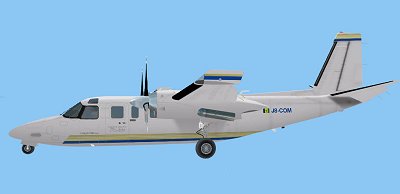
J8-COM
'François l'Ollonais'
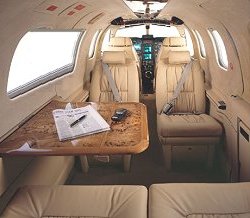
FS9
ONLY
TEXTURE
ONLY
|
Rockwell
Turbo Commander 690B
with
winglets
~ Veneaviones
The
origins of this prolific series of twins lies with two
former Douglas employees (one of whom was Ted Smith) who
formed the Aero Design and Engineering Corporation in
December 1944 after failing to interest their employer
in a design they were working on.
Their
original design was the six to seven seat L-3805, which
first flew on April 23 1948. This aircraft formed the
basis for the first Aero Commander production model, the
520, which seated five to seven people and was powered
by two 195kW (260hp) Lycoming GO-435s. Production began
in late 1951.
A
total of 150 Aero 520 Commanders were built through to
1954. Subsequent development led to the more powerful
560 series (1954) with geared engines, the 680 series
(1955) with supercharged engines, and the direct drive
normally aspirated 500 series (1958). Variants, apart
from the experimental 360, include the 560A which introduced
the 25cm (10in) stretched fuselage that became the standard
short fuselage length, the 560E which introduced the definitive
wing span, the 720 Alti Cruiser pressurised development
of the 680 and the later pressurised 680PF.
The
560 and 680 were joined by the stretched 680FL Grand Commander
from 1962. The 500 was introduced to production in 1958
and was originally intended as a low cost model.
In
1967 North American Rockwell took over Aero Commander
and the Grand Commander became the Courser Commander and
the 500 became the Shrike Commander (gaining its distinctive
pointed nose at the same time). The Shrike Commander was
the last Commander to remain in production, manufacture
ending in 1980.
The
final piston powered model to appear was the Rockwell
685 Commander, which was a piston powered Turbo Commander.
In
US military service, the designation for the aircraft
was originally L-26, in 1962 renamed to U-4 (Air Force)
and U-9 (Army). Two U-4Bs (ex L-26Cs), an Air Force version
of the 680, were ordered by the USAF as presidential aircraft
for President Dwight D. Eisenhower. They were used from
1956 to 1960 for short trips. They had the distinction
of being the smallest "Air Force One", the first
Presidential aircraft to have only two engines, and the
first Presidential aircraft to carry the familiar blue
and white colors.
|
|
|
Other ESSENTIAL Files:
Base aircraft available
HERE & with Winglets
|
Repaint by JF
|
|
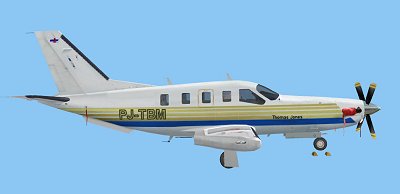
PJ-TBM
'Thomas Jones'
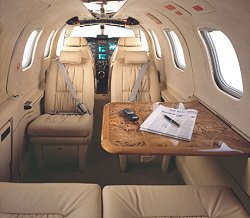
FS9
ONLY
TEXTURE
+ FDE ONLY
|
Socata
TBM700 A ~ Various see file
The
TBM-700 is a high performance single engine turboprop
powered light business and corporate transport.
The
TBM-700 is mainly optimised as a business transport in
competition with established twin turboprops, mainly Beech's
C90 King Air series. Unlike the similarly sized C90 King
Airs though, the TBM-700's single engine layout is a major
conceptual difference. With its single PT6 turboprop,
rather than two on the King Air, the TBM-700 offers significantly
lower operating costs yet comparable performance.
The
TBM-700 was originally developed in partnership between
Socata (Aerospatiale's General Aviation division) in France
and Mooney in the USA, hence the TBM designation. The
two companies formed TBM SA to build and market the TBM-700,
with development responsibility for the project divided
on a 70/30 basis between Socata and Mooney respectively.
The
first of three TBM-700 prototypes first flew on July 14
1988. French certification was granted in January 1990.
Shortly after the delivery of the first production aircraft
in December 1990, Mooney withdrew from the program, leaving
Socata with full responsibility for the aircraft.
The
pressurised TBM-700 is of conventional design and construction,
with a small amount of composite materials used in some
areas. Flight controls, flaps and most of the empennage
and fin are made from Nomex honeycomb and metal sheets.
Leading edges and undercarriage doors meanwhile are made
from a carbon and fibreglass composite. Entry to the cabin
is through a split upward/downward opening door in the
rear port fuselage.
Apart
from the base aircraft the TBM-700 is offered as the TBM-700C
freighter with a freight door and separate port side cockpit
door. Development of the stretched TBM-700S ceased in
1995.
|
Socata TBM 700C2
Aircraft certified to FAR Part 23 Amendment 44
Only available for N registered aircraft or countries
wherever applicable.
Applicability to be checked prior to sale with EADS Socata
Sales & Marketing Department
Certified ceiling 31.000ft (Caution: Depending upon the
country, restrictions may apply which limit tho operational
ceiling.
Loading:
Basic empty weight: 4,685 lbs 2.125 kg
Maximum zero fuel weight: 6,032 lbs 2.736 kg
Maximum ramp weight: 7,430 lbs 3.370 kg
Maximum takeoff weight: 7,394 lbs 3.354 kg
Maximum payload: 1,347 lbs 611 kg
Maximum payload with maximum fuel: 804 lbs 365 kg
Maximum luggage capacity in storage areas: 297 lbs 135
kg
Maximum landing weight: 7,024 lbs 3.186 kg
Performance:
Time to climb to 26.000ft at MTOW: 24 min
Time to climb to 31.000ft at MTOW: 27 min 30
Maximum cruise speed at 26.000ft: 300 KTAS 555 km/h
Economy cruise speed at 31.000ft: 255 KTAS 472 km/h
Certified ceiling: 31.000ft 9.468m
Distances:
Take-off: 2,832ft 865m
Landing without reverse: 2,427ft 741m
Ranges:
Maximum range (ISA conditions, max. take-off weight NBAA
IFR Reserve)
With full fuel economical cruise speed: 1,565 Nm 2.898
km
With full fuel maximum cruise: 1,315 Nm 2.435 km
With max. passengers economical cruise speed: 1,074 Nm
1.989 km
With max. passengers maximum cruise: 917 Nm 1.698 km
|
|
|
Other ESSENTIAL Files:
Base aircraft available
HERE
|
Repaint by JF
FDE by Karl Hajek
|
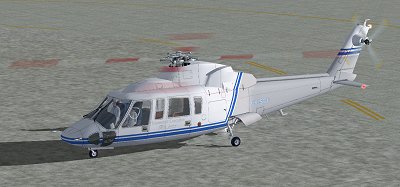
C6-SGF
FS9
ONLY
TEXTURE
ONLY
|
Sikorsky S76A
~ Nemeth Designs
Sikorsky's S76 is a popular mid size corporate and oil rig support helicopter.
Sikorsky began development work on the S76 (for a time named Spirit) in the mid 1970s and used technologies and experience gained from the military S70 Black Hawk program. The resulting S-76A was powered by two Allison 250C30S turboshafts and could seat 12. First flight was on March 13 1977 and FAA certification was awarded in November 1978.
The first improved model was the S76 Mark II (introduced in March 1982) with more powerful Allison engines and 40 detail refinements. The S76B is powered by two Pratt & Whitney Canada PT6B36s (the 101st and last B was due to be delivered in December 1998), while the S76C is powered by two Turboméca Arriel 1S1 engines. The S76A+ designation covers undelivered S76As subsequently fitted and delivered with Arriel engines, and S76As converted to Arriel power.
Current production is of the S76C+ with 18% more powerful FADEC equipped Arriel 2S1 engines. Certification of the C+ was awarded in mid 1996. Forthcoming improvements include composite blades, a quiet tail rotor with curved blades, an active noise and vibration control system, and an advanced health and usage monitoring system. A three LCD screen integrated instrument display system (IIDS) for engine and rotor information is now standard, supplementing the four screen Honeywell EFIS suite.
|
|
Other ESSENTIAL Files:
Base aircraft available HERE Update HERE
|
Repaint by JF
|
|


















































